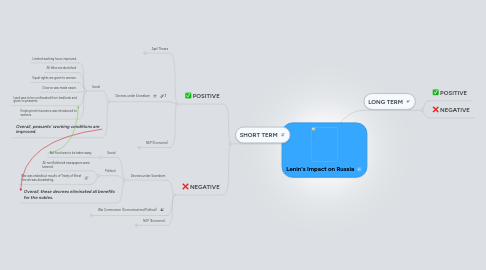
1. SHORT TERM
1.1. POSITIVE
1.1.1. April Theses
1.1.1.1. Food is rationed.
1.1.1.2. War is ended immediately.
1.1.1.3. All land is given to the peasants.
1.1.2. Decrees under Sovnakom
1.1.2.1. Social
1.1.2.1.1. Limited working hours improved.
1.1.2.1.2. All titles are abolished.
1.1.2.1.3. Equal rights are given to women.
1.1.2.1.4. Divorce was made easier.
1.1.2.1.5. Land was to be confiscated from landlords and given to peasants.
1.1.2.1.6. Employment insurance was introduced to workers.
1.1.2.2. Overall, peasants' working conditions are improved.
1.1.3. NEP (Economic)
1.1.3.1. Grain requisitioning was stopped.
1.1.3.2. Trading was made legal.
1.1.3.3. Factories and industries are allowed to sell goods and make a profit.
1.1.3.4. Electrification
1.2. NEGATIVE
1.2.1. Decrees under Sovnakom
1.2.1.1. Social
1.2.1.1.1. But food was to be taken away.
1.2.1.2. Political
1.2.1.2.1. All non Bolshevik newspapers were banned.
1.2.1.2.2. War was ended but results of Treaty of Brest Litovsk was devastating.
1.2.1.3. Overall, these decrees eliminated all benefits for the nobles.
1.2.2. War Communism (Economical and Political)
1.2.2.1. Cheka Police was set up in December 1917. (Political)
1.2.2.1.1. The Red Terror was launched and they arrested all oppositions and some were shot without trial.
1.2.2.1.2. Cheka seized surplus food from peasants because they were unwilling to sell their grain.
1.2.2.2. Famine (Economical)
1.2.2.2.1. Strict discipline was imposed.
1.2.2.2.2. Food was rationed. (Bread was sometimes as low as 200 grams a day.)
1.2.2.2.3. Money became virtually worthless. (By 1920, wages were often paid in food.)
1.2.2.2.4. "Killed up to five million people." pg64 Source 2.
1.2.3. NEP (Economic)
1.2.3.1. Prices for manufactured goods were high. Society was polarized into the rich and poor.
1.2.3.2. Unemployment remained a serious problem, particularly among young people.
1.2.3.3. This lead to high crime rate.
1.2.3.4. Overall, up to 1925, under NEP, there were only low levels of production and not much improvement was made. Food supplies soon became a problem again.
